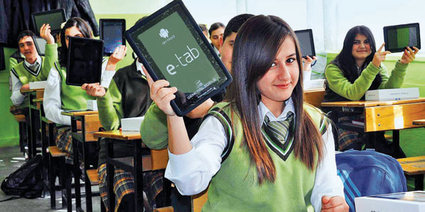Even if the results are not good every time, technology integration in education seems essential for 21st century learner profile... Technology is not a magic tool to readily provide activities; the teachers should create curriculum activities, design learning scenarios by using information and communication technologies.  In 21st century (Dede, 2009; Spires, H., Bartlett, M., Garry, A., & Quick, A., 2012) and beyond, developed and developing countries need highly qualified individuals. The schools, teachers, educations leaders, policy makers and companies devote serious effort to integrate technology into curricula to harvest such highly qualified individuals. Therefore, the educations systems, learning and teaching tools and materials, teaching and learning methods need to transform in order to reach contemporary education. We can easily see that every new technologies based on computers have a transformational effect on education. Even if the results are not good every time, technology integration in education seems essential for 21st century learner profile. Several research studies show that one-to-one learning technologies have a positive impact on learning and teaching (Bebell & O’Dwyer, 2010; Penuel, 2006; Sclater, Sicoly, Abrami, & Wade, 2006). The most motivating and appealing aspect of using one-to-one tablets or laptop or any other mobile technologies is to have access required information at any time any where via internet (Bebell & Kay, 2010). Moreover, the students can create their own class notes by using different software. Therefore information should be personalized (Spires, H. et al., 2012). As a result, they can learn in a meaningful way and they can archive and organize learning materials and projects in the form of an e-portfolio using their tablets, and share it with the rest of the world. This learning environment also makes teaching easier and change the role of the teachers from the only source of information to guiding, advisor, or coach of lesson (Livingston, 2009). Turkish education policy makers also devote an effort to transform education to prepare the individuals for digital age. Observations from the Pilot Schools and Interviews Even though the pilot projects is very new and it is so early to deduce conclusive results, we want to support students, teachers, and principals in the pilot schools in meetings in orders to provide pedagogical perspective. We discussed general opinions, concerns and expectations in our meetings. Some of the opinions of the teachers, vice principals, students were as follows:
The problems with LCD Smart Board are effected usage of tablets. Teacher cannot control the tablets with their computers. This situation creates huge classroom management problems. There is a need for classroom management software. The teachers cannot lock the tablets when the students take their tablets to “flight mode”. Students play games using tablets during the lessons, they have difficulty concentrating to lessons. The teachers should be able to create the exam sheets from the tablets; there should be a classroom management system such that students are able to get feedback and their exam results using their tablets. File sending and receiving, e-mail, forums should be allowed between teachers and teachers, students and students, teacher and students. This can also create a positive impact on communication in the school (Spires, Oliver, & Corn, 2011; Lei & Zhao, 2008; Mouza, 2008). Moreover, the students can share and send their homework and project with teachers and other students. Limited Internet connection permits the students and teachers access some web sites, which are official and permitted by MONE. The security issues, limited access to the Internet, and locked video-camera properties de-motivate the students and teachers’ using tablets in education (Drayton, Falk, Stroud, Hobbs, & Hammerman, 2010). During one of our school visits, we made an open survey by asking students “how many of you brought to tablets to school, today?” at one class of ninth grade students. Just three of thirty- four students had brought their tablets to the school. Interestingly and surprisingly this school was one of the top schools in terms of student achievement. One of the students said that they couldn’t do anything with tablets, since there are no office programs, they are not allowed to use Internet, they cannot use any means of communication, and they cannot use video or camera properties. They have electronic version of textbook and they preferred to bring textbook instead of tablets into class. Tablets are expensive, the students does not want to take the responsibility of tablets. As a result of this, development of e- content is also one of the most important issues in the pilot project.
The tablets have basic software for basic operations such as note taking and e-book reading. The expectations of students and teachers are more than e-books and r-books, more than scanned (or electronic) version of the textbooks. E-content should be enriched: with animations, tests, maps, interactive applications, and interactive test and exam questions. R-books should be available in teachers’ tablets, too. There should be office software to use word processing, spreadsheets and presentations to create projects or other activities. Internet usage area should be expanded (research tools, dictionaries, wikis, etc.), and it should be in teacher’s control. There is a need for information and communication teacher and technology technician support in every school. Teachers need more and hands-on training for technology integration to their teaching in their subject area. During the interviews, the teachers from the different subjects (e.g., math, science, history, geography, foreign language, etc.) indicate that they need training specialized in their subject to integrate tablet into classroom activities.
LCD Smart Board usage is more efficient compared to tablet usage. However, e-content is limited especially for tablets. Teachers’ general view is that tablets are unnecessary. Ministry of National Education gave the first training but it was not sufficient and sustainable. Although they feel unconfident on how to integrate tablets to their courses, they want training on its usage first. The software, the scanned version of the school books, and e-content in the tablets are not sufficient for integrate into education. The teachers are unhappy and worried about the fast change. The students’ achievement is found to decrease while the teachers and students are striving to integrate tablets to their learning and integration to the courses. Teachers’ another general feeling is pressure about they should constantly use the tablets and the LCD Smart Board. They wonder if the technology is the aim or tool. From that point, I can say that the vision and mission of one-to-one tablet project haven’t been combined, yet in Turkey based on the pilot project. Education leaders, principals, teachers, and students should be made aware of the meaning, impact, opportunities of one-to-one tablet project for teaching and learning. The teachers and policy makers should think and create teaching and learning activities beyond the classroom. Tablets and similar kinds of mobile technologies provide teachers, learner or anybody who want to learn whenever, wherever, they want. They should listen to a lesson podcast when they you are in a bus, work on their homework in a café house, create a biology video in a botanic garden, or a history presentation on museum visit, have an interview with people on the street about smoking, create an e-portfolio for the class notes and projects, have an exam online and take the quick feedback. The teachers should guide the students with such activities. Otherwise, using tablets or any other technologies will not create much impact on learning and will not motivate the teachers and students. Technology is not a magic tool to readily provide activities; the teachers should create curriculum activities, design learning scenarios by using information and communication technologies. There are many components to create a one-to-one tablet environment in education. In the future, the pilot projects will be in a much larger scale. It is important to know the obstacles and problems about the project for the further studies and advancement. One-to-one tablet project in education is not one time trial and should be made sustainable (Livingston, 2009). It is necessary to update the software, train the teachers, and develop the curriculum in the education faculties for the teachers’ readiness and training in order to achieve goals for the 21st century. References Bebell, D., & Kay, R. (2010). One to One Computing: A Summary of the Quantitative Results from the Berkshire Wireless Learning Initiative. The Journal of Technology, Learning and Assessment, 9(2). Retrieved from http://ejournals.bc.edu/ojs/index.php/jtla/article/view/1607 Bebell, D., & O’Dwyer, L. (2010). Educational Outcomes and Research from 1:1 Computing Settings. The Journal of Technology, Learning and Assessment, 9(1). Retrieved from http://ejournals.bc.edu/ojs/index.php/jtla/article/view/1606 Dede, C. (2009). Comparing frameworks for 21st century skills. In 21st Century Skills: Rethinking How Students Learn (pp. 51–76). Bloomington, IN: Solution Tree Press. Drayton, B., Falk, J. K., Stroud, R., Hobbs, K., & Hammerman, J. (2010). After Installation: Ubiquitous Computing and High School Science in Three Experienced, High-Technology Schools. The Journal of Technology, Learning and Assessment, 9(3). Retrieved from http://ejournals.bc.edu/ojs/index.php/jtla/article/view/1608 Lei, J., & Zhao, Y. (2008). One-to-One Computing: What Does It Bring to Schools? Journal of Educational Computing Research, 39(2), 97–122. Livingston, P. (2009). 1-to-1 Learning, Second Edition: Laptop Programs That Work (2nd ed.). International Society For Technology In Education. MEB. (2012). FATIH: Towards the Education of Information Age. Fatih Projesi Web Sayfasi - Yenilik Ve Egitim Teknolojileri Genel Mudurlugu. Official. Retrieved December 20, 2012, from http://fatihprojesi.meb.gov.tr/tr/icerikincele.php?id=12 Mouza, C. (2008). Learning with Laptops: Implementation and Outcomes in an Urban, Under-Privileged School. Journal of Research on Technology in Education, 40(4), 447–472. Penuel, W. R. (2006). Implementation and Effects of One-to-One Computing Initiatives: A Research Synthesis. Journal of Research on Technology in Education, 38(3), 329–348. Sclater, J., Sicoly, F., Abrami, P., & Wade, C. A. (2006). Ubiquitous technology integration in Canadian public schools: Year one study. Canadian Journal of Learning and Technology / La revue canadienne de l’apprentissage et de la technologie, 32(1). Retrieved from http://cjlt.csj.ualberta.ca/index.php/cjlt/article/view/80 Spires, H. A., Oliver, K., & Corn, J. (2011). The New Learning Ecology of One-to-One Computing Environments: Preparing Teachers for Shifting Dynamics and Relationships. Journal of Digital Learning in Teacher Education, 28(2), 63–72. Spires, H., Bartlett, M., Garry, A., & Quick, A. (2012). Digital Literacies and Learning: Designing a Path Forward. Friday Institute White Paper Series. NC State University: Raleigh, NC. Retrieved from https://www.fi.ncsu.edu/assets/podcast_episodes/white-paper-series/digital-literacies-and- learning.pdf
0 Comments
|
FollowAuthor
Archives
October 2020
Categories
All
|
